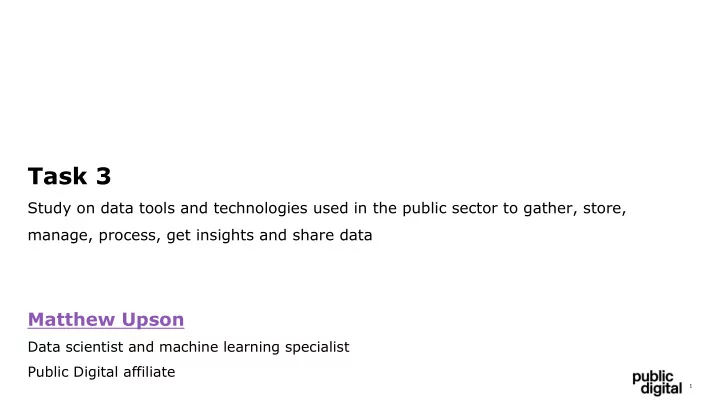

Task 3 Study on data tools and technologies used in the public sector to gather, store, manage, process, get insights and share data Matthew Upson Data scientist and machine learning specialist Public Digital affiliate 1
Based on four case studies 1. the Reproducible Analytical Pipelines in the United Kingdom; 2. the New Zealand government’s Integrated Data Infrastructure and Social Investment Analytical Layer; 3. Findata, a Finnish agency to enable the secondary use of social and healthcare data in the research, public, and private sectors; 4. and KOKE, an analytics solution for fraud detection in use by the Estonian Tax and Customs Board. 2
Based on four case studies 1. the Reproducible Analytical Pipelines in the United Kingdom; 2. the New Zealand government’s Integrated Data Infrastructure and Social Investment Analytical Layer; 3. Findata, a Finnish agency to enable the secondary use of social and healthcare data in the research, public, and private sectors; 4. and KOKE, an analytics solution for fraud detection in use by the Estonian Tax and Customs Board. 3
UK Reproducible Analytics Pipeline (RAP) What it is: a methodology for improving the production of statistical publications Developed by GDS and the DCMS in 2016. As technology, it used: - open source software - R and Python languages - Software version control (Git / Github) What was achieved: More than 30 projects, some achieving a 75% time saving over traditional methods of statistics production. Wide, and growing adoption across UK government departments. 4
Typical manual process for producing a statistical publication 5
Producing a statistical publication using a Reproducible Analytical Pipeline 6
Lessons learned ● Open source software can greatly improve data analytics in government ● RAP only solves part of the problem ● Approaches like RAP can take time to implement ● There can be skills shortages for the adoption of approaches like RAP ● RAP is as much about people as it is technology 7
NZ Integrated Data Infrastructure (IDI) and SIAL What it is: The IDI is a research database that holds anonymised data from across the public sector. The Social Investment Analytical Layer (SIAL) is a tool to improve the usability of the IDI by processing the raw data into an easier to use format. Developed by Statistics New Zealand in 2017. As technology, it used: - MS SQL - SAS, SPSS, R - Software version control (Git / Github) What was achieved: Access to public sector data for public sector agencies, and researchers subject to approval. The SIAL generated approximately $1m NZD in time savings since it was shared openly and has been re-used multiple 8 times.
9
Lessons learned ● Start small, test regularly, and iterate to meet users’ needs ● Good security practices are essential when managing personal data ● Standards for public trust and transparency ● Adopting and sharing open source software saves time and resources 10
To sum up, Task 3 case studies highlight the need to: ● Start with user needs (and recognise analysts as users) ● Work in the open and foster reusability ● Adapt to data readiness ● Use open source ● Invest in data capability at all levels ● Break down silos 11
Angie Kenny angie@public.digital Website https://public.digital/ Twitter @publicdigitalHQ
Recommend
More recommend